

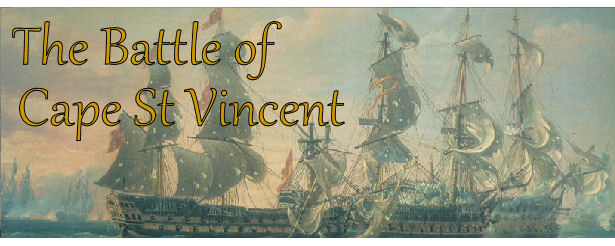
The Battle
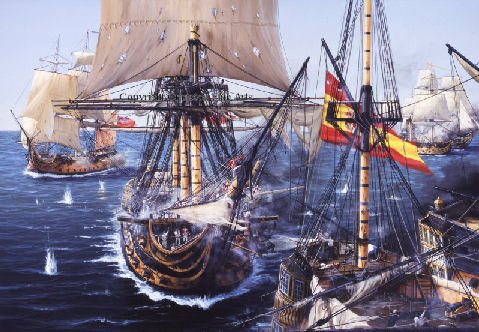
From his position in the Captain, near the rear of the British line, Nelson had a good view of events as they unfolded. He saw as, at 1pm, the Culloden began to open fire upon the rear-most Spanish ships, with the Blenheim approaching behind. He had seen Jervis' signals, and he saw that the Britannia was not turning.
Alarmingly, he then noticed that Córdova's division was beginning to turn to the east with the intention of getting round the rear-most British ships. He knew that if he continued to follow the Britannia and ignore Jervis' order to turn, the Spanish would be given time to get past them and become a serious threat.
So Nelson, in a remarkable display of initiative and ingenuity, took it upon himself to join the British van. He wore out of the line - that is, he turned away from the wind (tacking involved turning into it), and away from the Spanish. This was a faster way of turning, as it meant that the wind could catch the sails as the ship turned away from it. He then cut back through the line, ahead of Captain Collingwood's Excellent, and sped towards the Spanish and Troubridge's Culloden. Thanks to his quick-thinking and seamanship, he reached them just 10 minutes after the Culloden engaged.
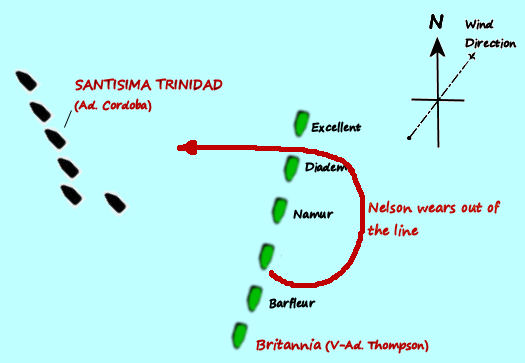
It was a risky move, because as the Captain approached alone she would come under heavy fire from five big Spanish ships, which was potentially devastating. But the Spanish gunnery was not very fast or accurate, which Nelson had probably counted on after his earlier visit to Cadiz and assessment of the Spanish ships and seamen.
In contrast, the Captain's gunners were highly trained, disciplined and experienced, and subjected Córdova's ships to fast, heavy and accurate fire. The move and devastating attacks took Córdova by surprise, and he gave up on his attempt to turn and continued on his original course. Later, Captain Miller of the Captain described the manoeuvre as like "turning them as two shepherd's dogs wou'd a flock of sheep".
The nervous Captain Calder of the Victory asked Jervis if he should recall the Culloden and Captain, but Jervis had faith in his intrepid captains.
"Engage the Enemy More Closely"
10 minutes after Nelson's move, Jervis signalled for the whole of the rear division to join him. Abandoning the strategy of all turning at the same point, they rushed to get into the action where they could. The Barfleur was a fast sailer, and Waldegrave had her wear in the same way as Nelson's Captain had done, and was able to join the line directly behind the Victory. The Britannia and Namur were slower and reached the end of the line, and thus hardly took part in the battle at all. The 64-gun Diadem was very quick, and joined the end of Parker's van division, behind the Irresistable. Collingwood's Excellent, also a fast sailer under his seamanship, was able to get ahead of the Victory.
Now he had a number of ships supporting the Culloden and Captain, Jervis signalled the fleet to 'engage the enemy more closely' - in other words, engage in a brutal, short-range melee attack. This would later become Nelson's favourite signal, well-suited to his fierce and ruthless desire for short and decisive battles. However, the speedy Diadem and Irresistable got a little carried away and Jervis later had to order them to cease firing as they came too close to the Victory and Excellent.
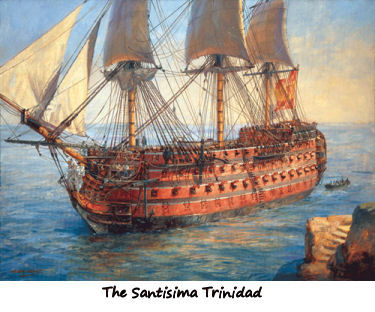 The monstrous Spanish flagship, Santisima Trinidad, was a
much-desired prize, and the British van focussed their attacks on her, so much
so that their commander, Rear-Admiral Parker, ordered them to move further up
the Spanish line to make room for new British ships to enter the battle.
So the Blenheim, Prince George and Orion moved up ahead of
the Captain. Noticing that the Santisima Trinidad was the
focus of the British attacks, five Spanish ships - the Mexicano, San
José, San Nicolas, Soberano and Salvador del Mundo)
moved close to protect her.
The monstrous Spanish flagship, Santisima Trinidad, was a
much-desired prize, and the British van focussed their attacks on her, so much
so that their commander, Rear-Admiral Parker, ordered them to move further up
the Spanish line to make room for new British ships to enter the battle.
So the Blenheim, Prince George and Orion moved up ahead of
the Captain. Noticing that the Santisima Trinidad was the
focus of the British attacks, five Spanish ships - the Mexicano, San
José, San Nicolas, Soberano and Salvador del Mundo)
moved close to protect her.
By this time, the Spanish were completely confused and disorganised and in no semblance of a line. As the British van reached his fleet, Córdova signalled 'Each unit should enter combat as soon as it can'. But because of the erratic positioning of the ships, some of the ones in the front didn't see the signal, and some of those that did were confused by it, as they couldn't believe that the admiral would order an attack while the fleet was so disorganised.
Later, Córdova said that the way the British fought, "in great good order, with a heavy and well-directed fire, decided the action in their favour."
By 2.pm, the Captain and Culloden were badly damaged. The Captain had lost her fore-topmast and so became difficult to manoeuvre. They were right in the thick of the action, receiving fire from several enemy ships. At 2.15pm, Jervis sent Collingwood in the Excellent to pass through the enemy line and get close to them.
So Collingwood set off ahead. The first ship he came to was one of Santisima Trinidad's entourage, the Salvador del Mundo. The Excellent fired heavily at her, until she surrendered - or, at least, it appeared to Collingwood that she had. Relying on one of his allies to take possession of her, Collingwood sailed on. But, somewhat dishonourably, the Salvador del Mundo opened fire upon the Orion as she came up to board. Orion, and then the Victory, fired on her, causing considerable damage and killing Captain Antonio de Tepes while killing or injuring another 200+ of her crew.
Next, he came to the San Isidro and let loose broadside after broadside upon her for 10 minutes until she, too, surrendered. This time, having seen the Salvador del Mundo's actions, Collingwood waited until he was sure that the San Isidro had hoisted English colours. Just to make extra sure that she didn't get away, Collingwood signalled to Jervis that the prize was not secure, and so the admiral sent the frigate Lively to take possession.
Now, the Excellent was able to come between Nelson's Captain, and the San Nicolas. She poured a couple of broadsides into San Nicolas at such close range and with such force that they passed straight through and hit the San José on the other side! As a result of such an onslaught, the San Nicolas and San José collided and their rigging became entangled. It also meant that the crew of the Captain were given a break, enough to be able to make some hurried repairs to their own rigging.
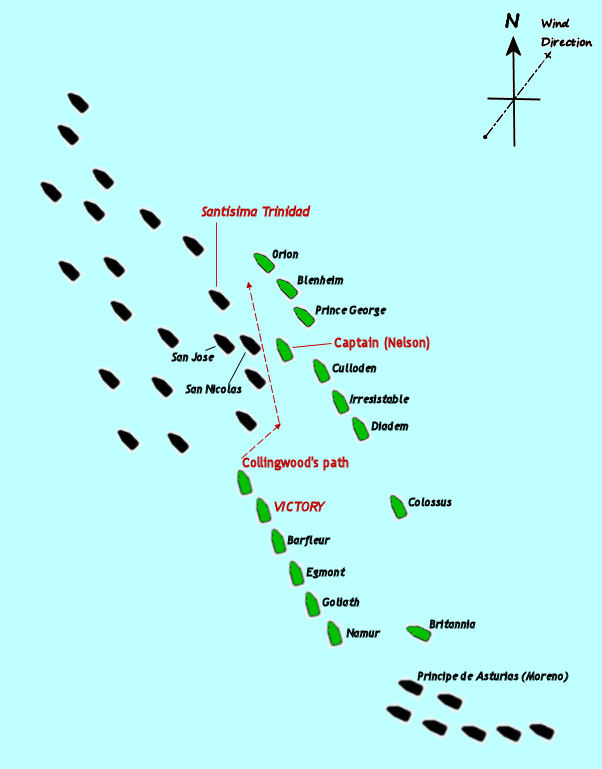
'Nelson's Patent Bridge for Boarding First Rates'
The Captain had sustained several casualties, including Nelson himself. He was hit in the abdomen by a large splinter of wood flung into the air by a cannon shot, which hit him with such force that he would have been knocked off his feet had not Captain Miller caught him and stopped him from falling.
Note about Nelson's injury: In Jervis' official dispatch, Nelson appears in the 'Officers Wounded' list as 'bruised, but not obliged to quit the deck'. The day after the battle, in a letter to Gilbert Elliot, he played down the injury, saying, "amongst the slightly wounded is myself, but it is only a contusion and of no consequence, unless an inflammation takes place in my bowels, which is the part injured". After the battle, he wrote 'A Few Remarks Relative to Myself in the Captain...', in which he again glossed over his injury, saying only: "...my bruises were looked at, and found but trifling, and a few days made me as well as ever." As it happened, he did suffer an internal injury from the blow, which would continue to trouble him for the rest of his life. Characteristically, though he often complained about his general ill-health, he did not feel sorry for himself over his war wounds - in the same letter to Elliot, he wrote philosophically, "But they who play at balls must expect rubbers".
As the Excellent moved away towards Santisima Trinidad, exposing the San Nicolas once more to the Captain, Nelson spotted an opportunity. With her wheel and rigging shot away, the Captain would be virtually impossible to move away, and the crew of the San Nicolas were temporarily occupied with trying to disengage her rigging from that of the San José. Nelson ordered Captain Miller to take his ship closer, and rammed the San Nicolas.
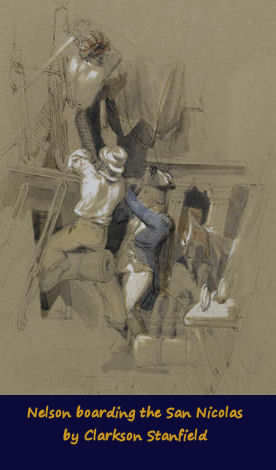 Nelson called for a boarding party. Miller offered to lead it, but Nelson
insisted on leading it himself, which was extremely unusual for a commanding
officer - but not unusual for him! As ever, he led by example, knowing that it was a dangerous
action and instinctively realising that, by putting himself at the forefront of
the attack, his presence would boost the morale and courage of his men.
Moreover, he always felt it was important for his men to realise that he would
not throw them into a situation into which he would not willingly jump himself.
It could also not have escaped his notice that doing so could well bring him
more personal glory.
Nelson called for a boarding party. Miller offered to lead it, but Nelson
insisted on leading it himself, which was extremely unusual for a commanding
officer - but not unusual for him! As ever, he led by example, knowing that it was a dangerous
action and instinctively realising that, by putting himself at the forefront of
the attack, his presence would boost the morale and courage of his men.
Moreover, he always felt it was important for his men to realise that he would
not throw them into a situation into which he would not willingly jump himself.
It could also not have escaped his notice that doing so could well bring him
more personal glory.
Clambering up onto the Captain's cathead (a sturdy beam at the bow of the ship which was used to support the anchor), a marine smashed one of San Nicolas' stern windows with the butt of his musket, and Nelson climbed through with the party close behind. It turned out that he was climbing straight into the Spanish captain's cabin.
The cabin doors were locked and the Spanish fired at them through the windows with pistols. Nelson's party broke through the doors with axes and stormed onto the quarterdeck, which must have been a shock to the Spanish commanders! The Spanish commodore, Don Tomas Geraldino, was killed in the process.
Captain Edward Berry, who had not been given a ship and so had been on board the Captain as a volunteer, led another party along the Captain's bowsprit (a long pole extending forward from the prow of the ship) and jumped down onto the poop deck.
It didn't take long for the officers of the San Nicolas to surrender the ship into Nelson's hands.
But Nelson hadn't finished yet. The San Nicolas was still entangled with the San José, a larger, 3-decked ship that loomed above her and was being fired upon by the British Prince George and had already been battered by the Captain and Excellent. Not only that, but Rear-Admiral Winthuysen had had both his legs blown off, and had been carried below deck where he was dying of his wounds. Another 150 of her crew were killed or wounded. Still, some of the remaining crew began firing their muskets out of the admiral's cabin at the stern, down onto Nelson's small boarding party. If Nelson lost the element of surprise, and allowed them to muster a counter-attack, they could easily overwhelm him and his men.
Ever the opportunist, Nelson leapt (literally) at the chance to take another prize, in an action that was as daring and courageous as it was unique and unprecedented.
He ordered some of his marines to fire their muskets into the San José's stern, hailed Miller, still aboard the Captain, and ordered him to send reinforcements onto the San Nicolas to keep her under control, and he placed sentries to keep the officers locked down. Then, Berry boosting him onto the main chains, he leapt over the side of the San José and onto the deck. Almost as soon as he landed, the Spanish captain leaned over the quarterdeck rail and called out the surrender of the ship.
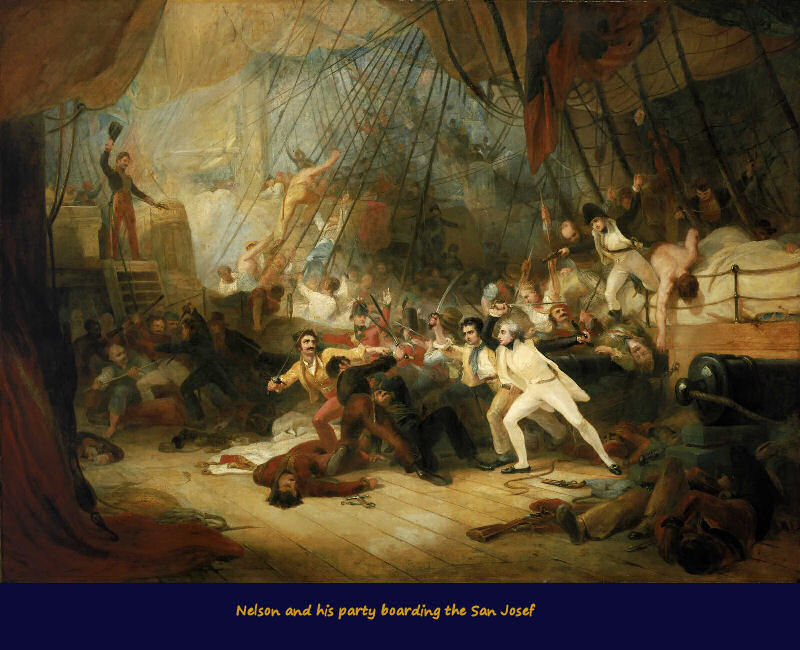
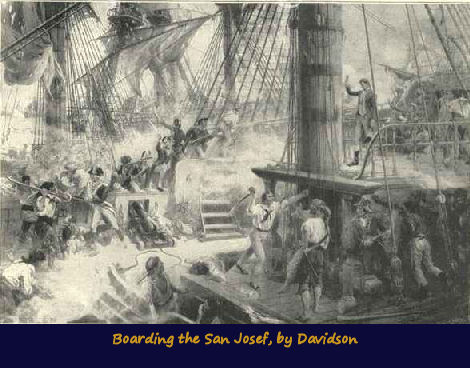
Nelson went up onto the quarterdeck where the captain presented him with his sword (the traditional symbolic gesture for a surrender) and informed him that the admiral was dying. Nelson double-checked that the ship really had surrendered by asking the captain to swear it on his honour, then sent him to gather up the officers of the ship. In a little ceremony which Nelson described as 'extravagant', the Spanish all handed him their swords, one by one, which he handed to one of his bargemen, William Fearney, who tucked them under his arm. With him were Edward Berry, Lieutenant Pierson of the 69th regiment (who were serving as marines), and three men - whom Nelson fondly called "old Agamemnons" as they had served with him on that ship - John Sykes, John Thomson and Francis Cook.
This incredible action, of boarding one first-rate and then using her as a springboard from which to board another, became known as 'Nelson's Patent Bridge for Boarding First Rates'.
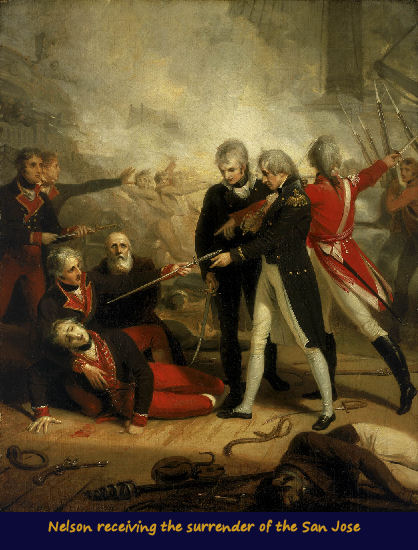
The Santisima Trinidad Controversy
After leaving the San Nicolas and San José to the mercies of Nelson and the Captain, Captain Collingwood in the Excellent finally reached the prize of all prizes - Santisima Trinidad. But by now both ships had taken quite a beating; and the Excellent's sails and rigging were so badly damaged that Collingwood couldn't manoeuvre her close enough, and Santisima Trinidad was little more than a hulk, having lost her masts and with over 200 killed or wounded.
The Excellent, Blenheim and Orion surrounded the Spanish giant like a pack of wolves around their prey. At 4pm, there were reports that she was flying a white flag, and then an English flag hoisted above the Spanish one, so some of the British thought that she had surrendered. James Saumarez in the Orion closest to her, certainly did. There were mixed entries in the logs of other British ships, but that of the Blenheim doesn't mention it and Collingwood, though further away, later said that though he had heard that she had surrendered, he didn't see it himself. Admiral Córdova didn't mention it in his report, but it's very unlikely that he would have even if it were true!
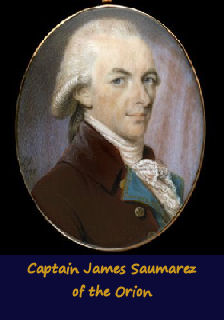 At 4.22pm, Jervis signalled from the Victory that he wanted the fleet to
end the battle and form back in to line. The Santisima Trinidad, if
she had ever hauled them down, rehoisted her colours and drifted in slow retreat
back towards her allies. She was a highly sought-after prize and would
have been Saumarez's, but to his bitter disappointment he could do nothing but
watch as she floated from his grasp.
At 4.22pm, Jervis signalled from the Victory that he wanted the fleet to
end the battle and form back in to line. The Santisima Trinidad, if
she had ever hauled them down, rehoisted her colours and drifted in slow retreat
back towards her allies. She was a highly sought-after prize and would
have been Saumarez's, but to his bitter disappointment he could do nothing but
watch as she floated from his grasp.
The timing of Jervis' signal may have been extremely unfortunate, but sunset was fast approaching and many of the British ships were very badly damaged and needed urgent repairs. The four prizes also needed securing, and the San Nicolas was on fire and needed to be dealt with. All of this would be very difficult to accomplish in the dark. Not only that, but Moreno's division had got round the British line and would be able to rejoin the Spanish fleet and potentially pose a threat. The San Pablo and Pelayo, detached by Córdova earlier in the day, also looked as if they might return.
Copyright Vicki Singleton 2013.